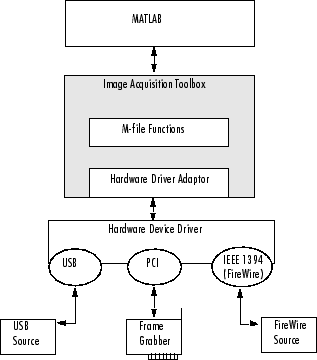Toolbox Components Overview
Introduction
Image Acquisition Toolbox™ enables you to acquire images and video from cameras and frame grabbers directly into MATLAB® and Simulink®. You can detect hardware automatically, and configure hardware properties. Advanced workflows let you trigger acquisitions while processing in-the-loop, perform background acquisitions, and synchronize sampling across several multimodal devices. With support for multiple hardware vendors and industry standards, you can use imaging devices, ranging from inexpensive Web cameras to high-end scientific and industrial devices that meet low-light, high-speed, and other challenging requirements.
The Image Acquisition Toolbox software implements an object-oriented approach to image acquisition. Using toolbox functions, you create an object that represents the connection between MATLAB and specific image acquisition devices. Using properties of the object you can control various aspects of the acquisition process, such as the amount of video data you want to capture. Creating Image Acquisition Objects describes how to create objects.
Once you establish a connection to a device, you can acquire image data by executing a trigger. In the toolbox, all image acquisition is initiated by a trigger. The toolbox supports several types of triggers that let you control when an acquisition takes place. For example, using hardware triggers you can synchronize an acquisition with an external device. Acquiring Image Data describes how to trigger the acquisition of image data.
To work with the data you acquire, you must bring it into the MATLAB workspace. When the frames are acquired, the toolbox stores them in a memory buffer. The toolbox provides several ways to bring one or more frames of data into the workspace where you can manipulate it as you would any other multidimensional numeric array. Bringing Image Data into the MATLAB Workspace describes this process.
Finally, you can enhance your image acquisition application by using event callbacks. The toolbox has defined certain occurrences, such as the triggering of an acquisition, as events. You can associate the execution of a particular function with a particular event. Using Events and Callbacks describes this process.
Note
With previous versions of the Image Acquisition Toolbox, the files for all of the adaptors were included in your installation. Starting with version R2014a, each adaptor is available separately through support packages. In order to use the Image Acquisition Toolbox, you must install the adaptor that your camera uses. See Image Acquisition Support Packages for Hardware Adaptors for information about installing the adaptors using MATLAB Add-Ons.
Toolbox Components
The toolbox uses components called hardware device adaptors to connect to devices through their drivers. The toolbox includes adaptors that support devices produced by several vendors of image acquisition equipment. In addition, the toolbox includes an adaptor for generic Windows® video acquisition devices.
The following figure shows these components and their relationship.
The Image Acquisition Toolbox Software Components

The Image Acquisition Explorer App
The functionality of the Image Acquisition Toolbox software is available in a desktop application. You connect directly to your hardware in the app and can then set acquisition parameters, and preview and acquire image data. You can log the data to a file or to the MATLAB workspace, and also generate a MATLAB script with the device configuration, right from the app.
To open the app, type imageAcquisitionExplorer at the MATLAB command line, or select Image Acquisition
Explorer on the Apps tab in MATLAB. For more information, see Get Started with Image Acquisition Explorer.
Supported Devices
The Image Acquisition Toolbox software includes adaptors that provide support for several vendors of
professional grade image acquisition equipment, devices that support the IIDC
1394-based Digital Camera Specification (DCAM), and devices that provide Windows Driver Model (WDM) or Video for
Windows (VFW) drivers, such as USB and
IEEE® 1394 (FireWire, i.LINK®) Web cameras, Digital video (DV)
camcorders, and TV tuner cards. For the latest information about supported hardware,
visit the Image Acquisition Toolbox product page at the MathWorks Web site (www.mathworks.com/products/image-acquisition).
The DCAM specification, developed by the 1394 Trade Association,
describes a generic interface for exchanging data with IEEE 1394 (FireWire) digital cameras
that is often used in scientific applications. The toolbox's DCAM
adaptor supports Format 7, also known as partial scan mode. The toolbox
uses the prefix F7_ to identify Format 7 video
format names.
Note
The toolbox supports only connections to IEEE 1394 (FireWire) DCAM-compliant devices using the Carnegie Mellon University DCAM driver. The toolbox is not compatible with any other vendor-supplied driver, even if the driver is DCAM compliant.
You can add support for additional hardware by writing an adaptor. For more information, see Support for Additional Hardware.
Note
With previous versions of the Image Acquisition Toolbox, the files for all of the adaptors were included in your installation. Starting with version R2014a, each adaptor is available separately through support packages. In order to use the Image Acquisition Toolbox, you must install the adaptor that your camera uses. See Image Acquisition Support Packages for Hardware Adaptors for information about installing the adaptors using MATLAB Add-Ons.